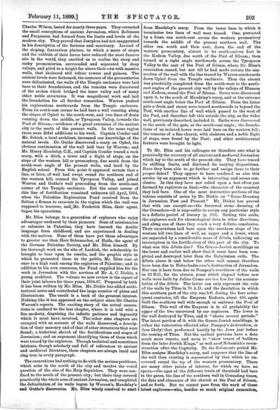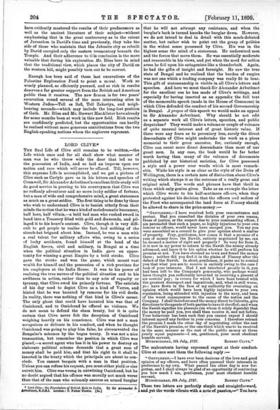THE RECOVERY OF ANCIENT JERUSALEM.* IT is now nearly two-and-thirty
years since Sir Charles (then Lieutenant) Warren began those excavations in Jerusalem which have for ever associated his name with the recovery of the dimensions of the city before its destruction by Titus. Warren's labours, which followed some excavations by Sir • Excavations at Jerusalem, 1894.97. By Frederick Jones Bliss, Ph.D.. Explorer to the Fund. Plans and Illustrations by Archibald Campbell Dickie, A.R.I.B.A. London Published by the Committee of the Palestine Exploration Fund. [129. 6d. ; subscribers, Bs. 6d.]
Charles Wilson, lasted for nearly three years. They corrected the small conceptions of ancient Jerusalem, which Robinson and Fergnsson had formed from the limits and levels of the modern city. They proved that Josephus had not exaggerated in his description of the fortress and sanctuary. Instead of the sloping, featureless plateau, to which a score of sieges and the rubbish of their havoc have reduced the most famous site in the world, they enabled us to realise the steep and rocky promontories, surrounded and separated by deep valleys, and piled to a height far above their own with massive walls, that sheltered still loftier towers and palaces. The ancient levels were fathomed, the contours of the promontories were deliminated, the walls of the Temple enclosure were laid bare to their foundations, and the remains were discovered of the arches which bridged the inner valley and of many other noble structures. It was magnificent work and laid the foundation for all farther researches. Warren pushed his explorations southwards from the Temple enclosure. From its south-east corner he laid bare a wall running along the slopes of Ophel to the south-west, and two lines of drain running down the middle, or Tyropceon Valley, towards the Pool of Siloam,—evidence of a great extension of the ancient city to the south of the present walls. In the same region there were fitful additions to his work. Captain Conder and Mr. Schick, a local architect, increased our knowledge of the natural levels. Dr. Guthe discovered a scarp on Ophel, the obvious continuation of the wall laid bare by Warren ; and Mr. Henry Mandalay, C.E., and Captain Conder traced a rock scarp, with a ditch, a tower and a flight of steps, on the slope of the western hill or promontory, due south from the south-west angle of the present walls, and hard by the English school. From this point it appeared certain that a line, or lines, of wall had swept round the southern end of the western hill, crossed the Tyropceon Valley, and joined Warren and Guthe's wall proceeding from the south-east corner of the Temple enclosure. But the exact course of this line of fortification remained unknown till April, 1894, when the Palestine Exploration Fund received from the Sultan a firman to excavate in the region which the wall was supposed to traverse, and„Mr. Frederick Bliss, their agent, began his operations.
Mr. Bliss belongs to a generation of explorers who enjoy advantages unshared by their pioneers. Sons of missionaries or colonists in Palestine, they have learned the Arabic language from childhood, and are experienced in dealing with the natives. None of them have put these advantages to greater use than Herr Schumacher, of Haifa, the agent of the German Palestine Society, and Mr. Bliss himself. By his thorough work on the site of Lachish, the scholarship he brought to bear upon its results, and the graphic style in which he presented them to the public, Mr. Bliss rose at once to a high rank among the explorers of Palestine; and in addition to his own resources, the Fund supplied him for the work in Jerusalem with the services of Mr. A. C. Dickie, a young architect. The volume we now review is the report of their joint labours for three years, 1894-97. Prepared by both it has been written by Mr. Bliss. Mr. Dickie has added archi- tectural notes and contributed the large number of plans and illustrations. The result is a book of the greatest interest. Nothing like it has appeared on the subject since Sir Charles Warren's reports. The exciting story of the actual excava- tions is confined to the last chapter, where it is told with a fine modesty, disguising the infinite patience and ingenuity which it must have involved. Thelother nine chapters are occupied with an account of the walls discovered, a descrip- tion of their masonry and of that of other structures that were found; a historical sketch of the fortifications and sieges of Jerusalem ; and an argument identifying those of them which were traced by the explorers. Though technical and sometimes intricate, though scholarly and full of references to ancient and mediaeval literature, these chapters are always lucid and ring true in every paragraph.
The excavations had nothing to do with the serious problems, which arise in the north of the city and involve the vexed question of the site of the Holy Sepulchre. They were con- fined to the south of the present city; but there they covered practically the whole area of ancient Jerusalem, and completed the delimitation of its walls begun by Warren's, Mandslay's and Guthe's discoveries. Mr. Bliss wisely resolved to start
from Mandslay's scarp. From the tower base in which it terminates two lines of wall were traced. One, protected by a fosse, ran north-east across the western promontory towards the middle of the present southern wall. The other ran south and then east, down the end of the western promontory, almost to its south-eastern foot in the Kedron Valley, due south of the Pool of Siloam; then turned at a right angle northwards across the Tyropceon Valley to the east of the Pool of Siloam, where Mr. Bliss's excavation ceased, but not till he had made certain the con- nection of the wall with the line traced by Warren southwards down Ophel from the Temple enclosure. Thus the circuit was practically completed from the south-west to the south- east angles of the present city wall by the valleys of Hinnom and Kedron, round the Pool of Siloam. Gates were discovered upon it, to the south of Mandslay's scarp, and at the extreme south-east angle below the Pool of Siloam. From the latter gate a drain and street were traced northwards to beyond the Pool, with another line of wall which passed to the west of the Pool, and therefore left this outside the city, as the wider wall, previously described, included it. Baths were discovered to the south of the gate, at the south-east angle ; the founda- tions of an isolated tower were laid bare on the western hill ; the remains of a fine church, with cloisters and a noble flight of steps, were found by the Pool; and other architectural features were brought to light.
To Mr. Bliss and his colleague we therefore owe what is practically the recovery of all ancient and mediaeval Jerusalem which lay to the south of the present city. They have traced its shifting limits, and disclosed its varying dispositions. Have they been able to go further and assign these to their proper dates ? They appear to have rendered us also this service by an argument which is interesting and seems con- clusive. In this they have not relied upon a test often put forward by explorers as final,—the character of the masonry they laid bare. One of the most instructive portions of the volume consists of notes by Mr. Dickie on " Stone-Dressing in Jerusalem Past and Present." Mr. Dickie has proved that with one exception—the furrowed stone - dressing of the Crusaders—it is impossible to assign any particular style to a definite period of history (p. 263). Setting this aside, the explorers seek for chronological data in other directions, and along one of these they reach a very definite conclusion. Their excavations laid bare upon the southern slope of the western hill two lines of wall, an upper and a lower, which are separated by a considerable mass of debris, indicating an interruption in the fortification of this part of the city. To what was this debris due? The Gruco-Jewish mouldings on the lower and earlier wall show that it must have been com- pleted and destroyed later than the Babylonian exile. The debris above it and below the other wall cannot therefore have been due to Nebuchadnezzar's destruction of Jerusalem. Nor can it have been due to Pompey's overthrow of the walls in 63 B.C., for the sixteen years which elapsed before new walls were built by Julius Caesar are too few for the accumu- lation of the debris. The latter can only represent the ruin of the walls by Titus in 70 A.D., and the desolation in which this southern part of the city was left during the four subse- quent centuries, till the Empress Eadocia, about 450. again built the southern wall wide enough to embrace the Pool of Siloam. This wall of the Empress is in all probability the upper of the two uncovered by our explorers. The lower is the wall destroyed by Titus, and it " shows several periods." The latest portion of it, with the Grmco-Jewish mouldings, is either the restoration effected after Pompey's destruction, or (less likely) that performed hastily by the Jews just before the coming of Titus. But the earliest portions have a date much more remote, and seem to "show traces of builders from the later Jewish Kings," as well as of Nehemiah's recon- struction after the Captivity. To the Solomonic period Mr. Bliss assigns Mandalay's scarp, and supposes that the line of the wall then existing is represented by that which he un- covered round the top of the western promontory. There are many other points of interest, for which we have no space,—the ages of the different levels of threshold laid bare in the gates, the line of the southern wall in Crusading times, the date and character of the church at the Pool of Siloam, and so forth. But we cannot pass from the work of these latest explorers—who, besides so much original excavation, have evidently mastered the results of their predecessors as well as the ancient literature of their subject—without emphasising that in the great controversy as to the extent of Jerusalem in David's time and previously, they take the side of those who maintain that the Jebusite city as rebuilt by David occupied only the eastern nromontory beneath the Temple. And their adherence to tl is conclusion is the more valuable that during his exploration Mr. Bliss bore in mind that the traditional view, which places the city of David on the western hill, might possibly turn out to be correct.
Enough has been said of these last excavations of the Palestine Exploration Fund to point a moral. Work so wisely planned, so efficiently pursued, and so rich in results deserves a far greater support from the British and American public than it receives. The new firman is for two years' excavation round several of the most interesting sites in Western Judea—Tell es Safi, Tell Zakariya, and neigh- bouring mounds—which may include the long-lost position of Gath. Mr. Bliss and Mr. Stewart MacAlister have already for some months been at work in this new field. Rich results are confidently predicted, but the opportunities can hardly be realised without more generous contributions from the two English-speaking nations whom the explorers represent.








































 Previous page
Previous page